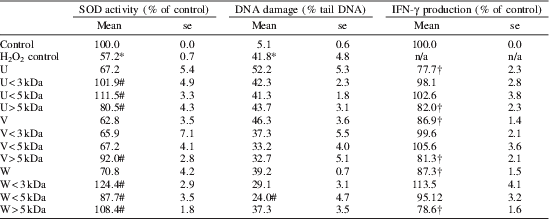Protein hydrolysates have been used as components of nutrition products, including geriatric and sports products, and in weight-control diets( Reference McCarthy, OCallaghan and OBrien 1 ). Brewers' spent grain (BSG), a co-product of the brewing industry, represents a unique source of protein hydrolysates. The aim of this study was to assess the in vitro bioactivity of BSG hydrolysates and fractionated hydrolysates.
Hydrolysates (designated U-W) were prepared from BSG using either Alcalase 2.4L, Corolase PP or Flavourzyme. Cytotoxicity was measured using the 3-(4,5-dimethylthiazol-2-yl)-2,5-diphenyltetrazolium bromide (MTT) assay in both U937 and Jurkat T cells. The antioxidant activity of the hydrolysates was determined in U937 cells by two methods – ability to protect against hydrogen peroxide (H2O2)-induced (100 μM 60 min) oxidative stress, by the SOD assay and H2O2-induced (50 μM×30 min) DNA damage, by the comet assay. An enzyme-linked immunosorbent assay (ELISA) was used to measure the effect of the samples on concanavalin-A (con-A) stimulated production of interferon-γ (IFN-γ) in Jurkat T cells, indicating their immunomodulatory potential.

Values are mean of three independent experiments. Statistical analysis by ANOVA followed by Dunnett's test. * Denotes significant difference in SOD activity/DNA damage, relative to control (P<0.05). # Denotes significant difference in SOD activity/DNA damage, relative to H2O2 control (P<0.01). † Denotes significant reduction in IFN-γ production, relative to control (P<0.05).
BSG protein hydrolysates were more cytotoxic in U937 than in Jurkat T cells (data not shown). Addition of H2O2 to U937 cells decreased SOD activity to 57.2% and increased % tail DNA to approximately 41.8% (P<0.05). Lowest molecular weight (m.w.) hydrolysates (<3,<5 kDa) showed strong protection against SOD reduction (P<0.01), particularly for fractionated hydrolysates of U and W. Only W<5 kDa significantly (P<0.01) repaired H2O2-induced DNA damage. Contrastingly, unfractionated hydrolysates and hydrolysates with higher m.w. (>5 kDa) possessed significant (P<0.05) anti-inflammatory potential, reducing IFN-γ production by up to 22.3%.
In conclusion, this study suggests BSG protein hydrolysates have bioactive potential; with low m.w. and higher m.w. fractionated hydrolysates demonstrating antioxidant and anti-inflammatory effects, respectively. These hydrolysates represent novel bioactive ingredients for inclusion in functional foods.
Funding for this research was provided under the National Development Plan, through the Food Institutional Research Measure, administered by the Department of Agriculture, Food and the Marine, Ireland.




